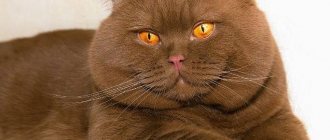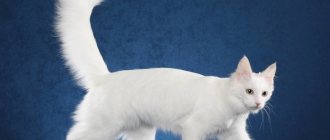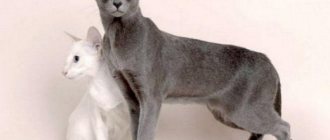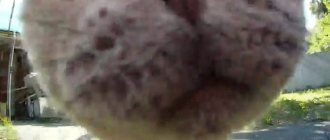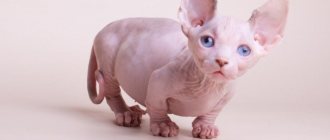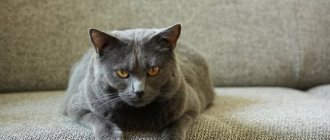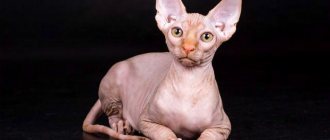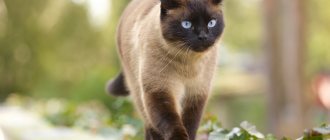Oriental cats are graceful representatives of felines of unearthly beauty, every year they win more and more hearts in the world of cat lovers. Year after year, they confidently rank among the top ten most popular cat breeds according to various cat fancier associations.
Orientals belong to the Siamese-Oriental group, along with Siamese cats, they are also called “Orientals”, “Asians” or simply “Ori”. Orientals are one of the most colorful breeds in the cat world. The variability of Ori colors reaches three hundred combinations. Playful, intelligent, friendly, impressively athletic and very sociable - they are suitable for large families with children.
Origin story
The word “Oriental” is translated into Russian as “Eastern”, so you can often hear this breed being called by Orientals or Asians. The Oriental breed is quite young, it originates from the Siamese cat and is distinguished by a variety of colors. Written references to the solid-colored Siamese cat, later called the Oriental, date back to the late 19th century.
It was not until the 1950s that European breeders began to develop the cat into a recognized breed by crossing Siamese cats with Russian Blues, British Shorthairs, Abyssinians and Domestic Shorthairs, and then crossing the offspring with Siamese.
Several American breeders took an interest in Orientals and formed Oriental Shorthair International, a club that won recognition for the breed from the Cat Fanciers' Association in the 1970s. The increase in color and pattern variations helped popularize the breed. The Oriental is the tenth most popular breed recognized by the CFA.
Character
Mischievous little ears
Orientals cannot be classified as calm pets who prefer to lounge on the sofa. They are extremely active and playful. restless creatures. They cannot live without everyone's attention. Therefore, sometimes they obsessively demand affection and care from their owners, regardless of whether they are busy or not.
Since they are tactile cats, they always try to sit on their owner’s lap. And if you pet your pet at the same time, then happiness will know no bounds.
"Talkative" beyond measure. Sometimes it seems that they are really saying something, only in their own language. Almost all actions performed are accompanied by various sounds: hissing, grunting, meowing. These cats also cannot be denied intelligence and intelligence. Therefore, they are easy to train.
Black orietal
Another character trait of Orientals is curiosity. They are interested in everything: what is happening outside the window, as well as in the house. They can sit on the windowsill for hours, watching the movement outside. Closed boxes and cabinets attract the most attention. No matter what it takes, they will definitely get in there and deal with the contents.
Touchiness is in the blood of these cats. This trait is inherited from the Siamese. If someone offends them, the pet will not react outwardly and will seem indifferent. Only internal experiences will not leave him for long.
Rare white color
Cats quickly become attached to the owner and all family members. Loneliness is difficult to bear and they are very bored when no one is home. They get along with other pets without problems if they grow up together from early childhood. They will not show aggression and rage, regardless of the circumstances.
Description of the breed
Known for its elongated head, tall ears and slender legs, the Oriental Shorthair may seem extreme compared to other cat breeds. The Oriental cat's facial features may not be to everyone's taste, but her temperament makes up for her odd body proportions.
Orientals in the extreme type are a representative of the breed with pronounced breed traits. Low-set ears, an elongated muzzle, a straight profile, very short and close-lying hair and a thin body constitution are the decisive factors that will affect the final price of an Oriental cat.
The appearance of such extreme Orientals is very bright and not everyone likes it, but they are good for breeding and developing the breed, as they help to consolidate one or another external trait in kittens.
These cats command all the attention they can get and are particularly intelligent and receptive to learning. In addition, they require minimal care and are very fond of children.
INTERESTING! Typically, the most common reason for not adopting a cat as a pet is an allergy caused by the allergen agent Fel-d1. Oriental Shorthair cats can be virtually hypoallergenic because they produce lower amounts of the Fel-d1 allergen than most breeds.
Oriental cat standard
Description of appearance:
- Body: this is one of the main characteristic features of Orientals and the entire eastern group - an elongated body, limbs, and a long tail. The body is thin-boned, graceful, athletic, fit. The tail is long, thin, like a whip. The chest part of the body protrudes, sometimes you can see the sternum in the shape of a keel. Male weight up to 6 kg, female up to 4.5 kg.
- Head: absolutely triangular. The shape of the ori head is in the form of an equilateral triangle with corners at the extreme points of the ears and chin. It is flattened, there is no transition between the tip of the nose and the forehead, the profile is straight.
- Eyes: The eyes are large, the color of the eyes depends on the color of the animal, mainly green and blue. The eyes are elongated, located obliquely, parallel to the sides of the triangular muzzle. Inconsistency between eye color and coat color is a disqualifying sign, along with strabismus.
- Nose: The nose is fairly wide, the profile is straight and long. In kittens, the bridge of the nose may be sunken, but it straightens out with age.
- Ears: Large, triangular, wide at the base and set far apart. The ears are arranged in such a way that the overall head has the shape of an equilateral triangle, and the pointed tips of the ears are its corners.
- Limbs: long, fine-boned, with small oval paws. The gait is graceful.
- Coat: short, silky, without undercoat, lying close to the body.
- Acceptable colors: more than 300 combinations - Orientals are rightfully the most colorful cats among all breeds.
Main colors:
- ebony (black solid), paws and nose are black, eyes are green;
- red , bronze (no pattern), paw pads and nose – pink;
- lavender (lilac, without blue shades), paws and nose are pink-lavender, eyes are bright green;
- Havana (brown, chocolate) – paws are brown-pink, nose is brown, eyes are bright green;
- blue (gray with blue, with an admixture of silver) - the pads of the paws and nose are blue, and the eyes are green;
- cream (fawn), fawn (beige), cinnamon (red, light brown), pink paws and nose;
- tricolor (tortoiseshell), a combination of white, black and red colors; the pads and nose are pink, black spots are possible;
- white (without yellowness), paws and nose are soft pink, eyes are blue (foreign white), green, or one is blue and the other is green.
These are the main solid colors, and Ori can also have a tabby color (spots, brindle stripes, marbled, ticked, etc.) superimposed on any of the main colors and smoky (this is when a hair of the coat is not completely dyed, it is white at the tip).
Health
Although Asians are a generally healthy breed, they do have a tendency to develop several health-related problems. Progressive retinal atrophy and lymphoma are common diseases in this cat breed. Other characteristic diseases: amyloidosis and congenital heart problems such as megaesophagus or hypertrophic cardiomyopathy.
Typically, the main diseases begin to develop at the age of 6 years and older. The health status is influenced by environmental factors, nutrition and activity of the animal.
It is advisable to have enough space for the pet to move and to feed it in a balanced manner. Many breeders prefer mixed nutrition. Oriental cats have special dietary requirements. They need a high quality cat food that contains the vitamins and taurine found in meat products.
Health problems can also arise from improper care of your pet. If you brush your Oriental's hair too hard and with the wrong brush, your cat may develop skin inflammation. This is due to the fact that Orientals lack a protective undercoat and the skin is easily damaged.
Character of Orientals
The character of the Ori can be described in two words - “center of attention.” Asians always want to be the center of attention. They don't care if you have a job, watch TV or read a book. They will jump on your lap and demand your attention.
They are also very talkative. A million shades, not a single repeating sound - this is how the owners describe the communication of the Oriental. Whether it's a contented purr, a hiss, or a meow, their voices will be heard all the time. If you ignore your Oriental kitty for too long, it can drive you crazy with its loud cries for attention.
The voice of Oriental cats becomes louder and more demanding at certain moments, for example, they want to eat, they want to relieve themselves, or they are in sexual heat, the rest of the time the volume of their voice is average.
Important! Often people do not realize the degree of talkativeness of Asians, sometimes this is the reason for owners' refusals and the cats being re-adopted to another family.
The talkativeness and loudness of Orientals can be regulated by education, the main thing is to do this during the kitten’s formation period, namely from 3 to 6 months. The owner's behavior must be firm and consistent. You shouldn’t allow yourself to shout at Easterners - they are very touchy. Easily respond to raising the tone of voice. You need to communicate softly, firmly, and encourage with positive reinforcement.
Important! Orientals need attention; if you are at work all day, be prepared for a violent manifestation of emotions in the evenings, and sometimes this can last all night. If you are forced to leave your pet alone all day, then it is worth getting a companion for him. It could also be an Oriental or another breed. Check with your breeder.
Ories are very smart animals, they are considered one of the smartest cat breeds. Therefore, they are quite trainable, and not only the rules of behavior, but also various tricks. You can teach your Oriental kitty a number of tricks, including how to respond to her name, sit, jump through hoops, and even give high fives (high fives). Because these cats enjoy all the attention they can get, they can become outstanding trick performers.
If you are patient and dedicated, and use positive reinforcement techniques, you can teach your Oric a huge variety of impressive tricks.
Children and family, other animals
Not all cats are suitable for large families, and especially not for small children. However, this does not apply to Oriental Shorthair cats. Their playfulness, intelligence and willingness to do anything for attention make them ideal companions for large families.
One of the disadvantages of owning an Oriental Shorthair is that it will become jealous of your attention if you bring home another pet. Of course, there is always a chance that an Oriental kitten will become friends with a new pet, but his constant need to be the center of attention can complicate the situation. Therefore, it is worth introducing a new animal into your home after consulting with an Oriental breeder.
The long legs and slender bodies of Oriental cats look elegant and athletic, they are enviable athletes and love to climb, jump and play all day long. Buying interactive cat toys and a cat tree house will make your Oriental the happiest kitty on the planet. Their playfulness does not go away as adults.
A quiet and strict home environment is not suitable for these cats. They need regular play and lots of social interaction.
Colors
The most common color among Orientals is chocolate (Havana). Such cats have a rich tone throughout their body (even the tip of the nose), only the paws are noticeably lighter. Other popular colors:
- brindle;
- marble;
- ticked;
- tabby;
- blue;
- cinnamon (light brown);
- faun (beige);
- red (scarlet);
- lilac;
- black;
- white (rare).
beautiful color of the cat
Photos of colors
Who is not recommended to have an ori?
You should not have a pet of this breed if you:
- Do you plan for your pet to spend half the day alone while you are at work?
- You don’t have the strength, patience, desire and time to educate an Oriental.
- Don't like cats that are always nearby and prefer those who are on their own.
- You don't like talkative animals; loud noises irritate you, and you prefer peace and quiet.
- Spend part of your time on the road or move frequently.
Buy an oriental cat
A purebred oriental kitten can be bought at a nursery, but it is better to ignore sites like Avito. Why? In nurseries you can be guaranteed to get a healthy animal, examined and purebred, but in someone else’s hands a pet may simply be unhealthy. If the pedigree contains the name Casimir, the ancestor of many representatives of the oriental cat breed, then it is better to quickly purchase a baby before someone smarter takes it. The origin of the future family pet must be impeccable in all respects.
The cost of a kitten is high: 20,000 – 40,000 rubles, but you don’t mind the money for such a cat.
Care
Wool
Oriental wool is very easy to care for. Their short and smooth coat does not require daily brushing. It is shiny, fits tightly to the body and does not shed as often as other cats. Orientals have no undercoat.
The Oriental's fine fur does not pick up much dirt and debris, so there is no need to bathe it often, otherwise you can damage the coat by removing the protective sebum on its skin.
It is better to clean the fur with soft silicone brushes; this should be done no more than once every 4 weeks. The animal's ears and eyes require care, mainly wiping with lotion and periodic examination for abnormalities in ear and eye discharge.
Nutrition
Orientals are not prone to overeating, so you can leave dry food available to your pet at all times. At first, kittens eat often, later they choose their own diet. You can see our rating of dry food for adult cats here.
It will be enough on your part to keep the food and water bowls full at all times.
Important! Some nurseries practice mixed nutrition. If your kitten is from such a nursery, then it may need to be additionally fed with meat or dairy products. Be sure to consult your breeder when choosing food for a kitten.
Walking your pet
Orientals are well kept in apartments. They do not suffer from lack of walking on the street or in the garden. Walking your pet is possible on a leash.
If your cat does not wear down its claws on walks, then you definitely need to install a scratching post in your apartment and train it to use it. Like any other useful habit, it is better to start learning from an early age.
Silver and smoke
Silver tabby is a dark pattern (marble, spot) on a white, sort of silvery background. Smoke is a solid color version of the silver tabby. This color looks like the main color, but the roots of the hair are white. When you blow on the fur, a contrasting white undercoat is visible. This is also noticeable when the animal moves.
Silver and smoke are dominant colors, i.e. a kitten with silver can only be born if one of the parents has silver or smoke. The silver (smoke) gene is designated I.
Table of combinations of parental genotypes for gene I
Breed card
| Characteristics of a cat | Notes | |
| General information | Oriental cats come from the Siamese line. It was from the Siamese that a strong character, playfulness and piercing eyes were passed on, although not necessarily blue. | Monochromatic cats are more popular |
| Character | Very affectionate, talkative and active cats. They require a lot of attention and will seek it using any available method. | |
| Appearance | Smooth-haired, elegant cats with a thin, elongated body and a triangular head. Lots of colors, some potential combinations haven't even appeared yet | |
| Behavior at home | They miss their beloved owner, so if you are away from home for a long time, get two Orientals. Being in a pair, cats will not be so bored and will not destroy the apartment in search of entertainment. They like to tap their paws on the floor to attract attention. | A very talkative breed. The voice of Orientals is loud and similar to the cry of a child, and sometimes even to a car horn. |
| Care | Short hair requires minimal grooming. It is enough to comb 1-2 times a week | Oris love the ritual of combing very much, because this is additional attention from the owner |
| Health problems | Sometimes hereditary heart disease | |
Dominant white
The dominant white W gene suppresses all other color genes - red, black, pattern, etc. However, underneath the white coat there are recessive genes for other colors and patterns, so white cats can have both white and non-white kittens. Many white kittens have a spot on their head that reveals their hidden recessive color. With age, this spot disappears.
Table of combinations of parent genotypes for the W gene
white with green eyes | white odd-eyed | foreign white: white with blue eyes |
More about white color
How to choose a kitten
The baby must be purchased from a nursery. Carefully check all documents and the presence of pedigrees. Find out additional information about the nursery, study the nursery website, reviews on third-party resources. You can come to the exhibition and chat with Oriental breeders, learn more about the breed. Cat lovers' clubs often host seminars on breeds, where you can also learn a lot of important things and talk with cat breeders.
If you want an Oriental of a certain color, you may have to wait several months for a certain kitten. Responsible breeders do not give away kittens before 12 weeks.
The cost of a kitten depends on its type . Extreme type kittens are more valuable. The price for kittens starts around 15-20 thousand rubles. A kitten for breeding will cost 50 thousand rubles or more.
Interesting Facts
not only interesting in appearance.
Oriental breed cats are interesting in many respects. Here are some fun facts about them:
- popularly called “rainbow” due to the variety of colors;
- Orientals are almost the only representatives of cats who do not have genetic pathologies;
- these are long-livers, since their lifespan can reach 20 years;
- before official registration, Orientals were called “one-color coffee Siamese”;
- oriental cats need constant tactile contact with their owners and active games, otherwise they begin to meow loudly;
- jealous of their owner's attention to other people and even objects;
- Orientals never release their claws, so it is safe to leave children with them;
- cats show devotion, characteristic only of dogs;
- They are popularly called “talkers” due to their inability to remain silent for even a few minutes.
